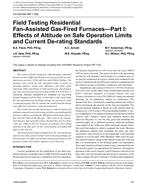Description
This paper is based on findings resulting from ASHRAE Research Project RP-1182
The results of field testing four induced-draft residential furnaces at three different altitudes are presented. The test altitudes were sea level, 2250 ft (685 m), and 6700 ft (2040 m). The furnaces were tested for safe operation under a variety of derating schemes, steady state efficiency, and nitric oxide emissions while operating on both natural gas and propane gas. The test protocols used were from ANSI Z21.47/CSA 2.3 American National Standard/CSA Standard for Gas-Fired Central Furnaces (ANSI 2001). In this Part I, the results from the safe operation and derating schemes are presented, while a companion paper, Part II, contains the results from the steady state efficiency and nitric oxide measurements.
The results showed that the furnaces could be fired at all altitudes using the sea level settings of orifice size and manifold pressure without exceeding the 400 ppm carbon monoxide air free (CO-AF) limit in the flue gas. This is due to the venturi-style burners that naturally reduce the fuel flow rate by about 1.8% per 1000 ft (305 m) increase in altitude. Over firing resulted in the flue gas CO-AF concentration exceeding 400 ppm in only one test.
The measured CO and calculated CO-AF concentrations showed the same general trends with increasing altitude for both test fuels. No effects of altitude on the performance of the ignition systems (hot surface igniters) were observed.
Units: Dual
Citation: ASHRAE Transactions, vol. 115, pt. 1, Chicago 2009
Product Details
- Published:
- 2009
- Number of Pages:
- 18
- File Size:
- 1 file , 8.8 MB
- Product Code(s):
- D-CH-09-046




